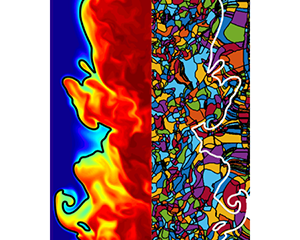Article contents
Dissipation element analysis of non-premixed jet flames
Published online by Cambridge University Press: 20 October 2020
Abstract

The dissipation element analysis is applied to the mixture fraction fields of a series of datasets from direct numerical simulations of non-premixed temporally evolving jet flames with jet Reynolds numbers ranging from 4500 to 10 000 and varying stoichiometric mixture fractions. Dissipation elements are space-filling regions where a scalar field behaves monotonically and allow for the analysis of scalar fields in homogeneous isotopic turbulence as well as in complex, highly inhomogeneous and anisotropic flows such as turbulent flames. Statistics of the dissipation element parameters of non-premixed flames are compared to those obtained from non-reacting jets. It is found that the universality of the normalized length distribution of the dissipation elements observed in non-reacting cases also holds true for the reacting flows. The characteristic scaling with the Kolmogorov micro-scale  $\eta$ is obtained as well. The effects of combustion on the scalar difference in the dissipation elements are shown and are found to diminish as the Reynolds number and the fuel dilution is increased. The dissipation elements provide the means for a local comparison of the turbulent and characteristic flame scales. A new regime diagram for non-premixed combustion is introduced using coherent structures in the scalar fields, the dissipation element parameters for a local classification of the turbulent flame surface into flamelet-like zones and fine-scale mixing zones in addition to the burning and non-burning zones. The soundness of the regime diagram and the potential consequences for combustion modelling in the individual regimes is demonstrated by the investigation of the correlation between the chemical field and the dissipation element parameters in the individual regimes.
$\eta$ is obtained as well. The effects of combustion on the scalar difference in the dissipation elements are shown and are found to diminish as the Reynolds number and the fuel dilution is increased. The dissipation elements provide the means for a local comparison of the turbulent and characteristic flame scales. A new regime diagram for non-premixed combustion is introduced using coherent structures in the scalar fields, the dissipation element parameters for a local classification of the turbulent flame surface into flamelet-like zones and fine-scale mixing zones in addition to the burning and non-burning zones. The soundness of the regime diagram and the potential consequences for combustion modelling in the individual regimes is demonstrated by the investigation of the correlation between the chemical field and the dissipation element parameters in the individual regimes.
JFM classification
Information
- Type
- JFM Papers
- Information
- Copyright
- © The Author(s), 2020. Published by Cambridge University Press
References
REFERENCES
- 11
- Cited by


